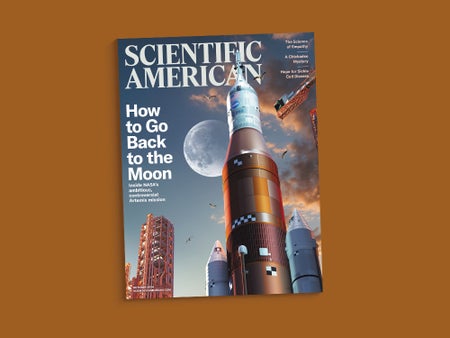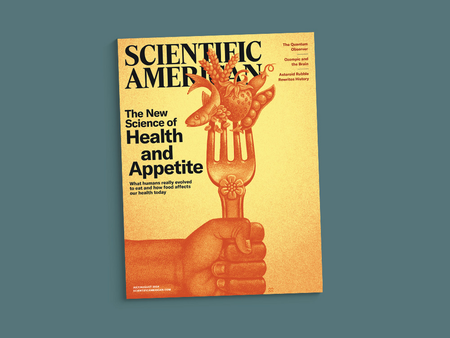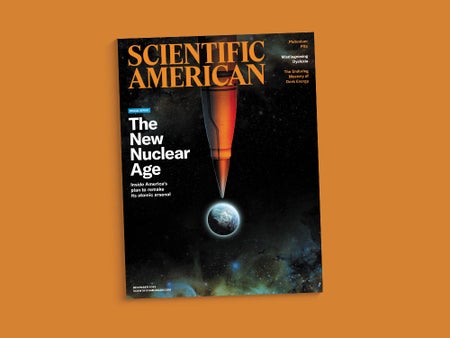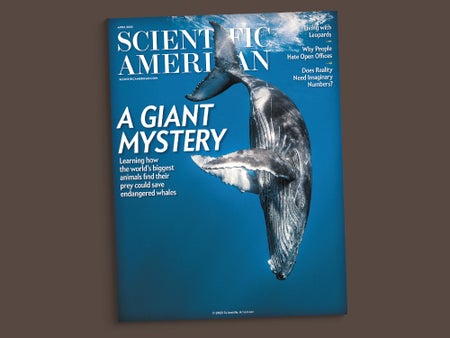
Curiosity, Horses and Hypochondria
Discovering weird new shapes, turning oil rigs into reefs and making the ocean absorb more greenhouse gases
Laura Helmuth was formerly editor in chief of Scientific American. She previously worked as an editor for the Washington Post, National Geographic, Slate, Smithsonian and Science. She is a former president of the National Association of Science Writers. She is currently a member of the National Academies of Sciences, Engineering, and Medicine's standing committee on advancing science communication and an advisory board member for SciLine and The Transmitter. She has a Ph.D. in cognitive neuroscience from the University of California, Berkeley. She recently won a Friend of Darwin Award from the National Center for Science Education. Follow her on Bluesky @laurahelmuth.bsky.social

Curiosity, Horses and Hypochondria
Discovering weird new shapes, turning oil rigs into reefs and making the ocean absorb more greenhouse gases

We Are Living in a Golden Age of Apples
Apple experts divide time into “before Honeycrisp” and “after Honeycrisp,” and apples have never tasted so good

Lucy Turns 50, and Dark Energy Gets More Mysterious
What works to improve health equity? And it might be time to end the leap second

Going Back to the Moon, Researching Chickadee Hybrids and Understanding Addiction
This month’s issue covers the reasons it’s so hard to go back to the moon, the science of empathy and new advances in treating sickle cell disease

New Insights on Dinosaurs, Pain and Carbon Capture
How we’ll learn more about dark matter, quantum gravity and substitutes for lab animals

New Understandings of Food, Fat, Fitness and Evolution
Quantum observers, migrating mangroves, the deep history of an asteroid and understanding appetite in this issue of Scientific American

RNA, Grizzly Bears and Anxiety Treatments Show That Science Is Never Done
Explore the new science of weird chemistry, anthropogenic evolution and near-death experiences

The Dazzling New Science of Feathers
Reducing noise improves health, JWST’s galaxies change astronomy, and there’s new hope for people with prostate cancer

New Insights from AI, Strange Metals and Parents of LGBTQ Kids
AI has deciphered ancient texts, learned new math and provided new ideas about human consciousness

A Solar Eclipse, Cancer Treatments and Robots with AI
New research reveals the origins of stars, sleep-based treatments and the planet’s limits

A Quantum Clock That Is Ticking Down, the Turbulent Milky Way and Dinosaur Lives
Why did matter outlast antimatter? And clumps of cells can learn and remember

Vitamin D Hope and Hype, Cosmic Voids and Preventing Depression
Alaska’s rusting rivers, einstein tiles and the new science of asexuality

Dyslexia, Dark Energy and a New Arms Race
The risks of a $1.5-trillion plan to build up the U.S. nuclear arsenal

Women Who Hunt, Organ Transplants and 50 Years of the Endangered Species Act
Why scary things can be fun, how to grow materials in space, and language’s influence on the mind

Introducing Scientific American’s Redesign, Newsletter and Podcasts
Geoengineering is happening, AI wants to talk with animals, and why we aren’t going to live in space

Narcissists, Dinosaurs, Deep-Sea Mining, and More
The hottest stars, how AI learns and new vaccines for RSV

Inside the Minds of People, Parrots and Bees
Tornados are moving east, OSIRIS-REx’s asteroid sample is coming to Earth soon, and there’s fresh treasure under the seafloor

Introducing Scientific American’s New Today in Science Newsletter
Sign up for a daily dose of discovery and awe

Answering Questions about Boring Numbers, Disasters, Fusion, and More
How electrons move, multiple personalities form and hookworms spread among pet dogs

New Understandings of Witch Trials, Synthetic Morphology and the Moons of Jupiter
Physicists attempt to weigh a vacuum and resolve the “worst theoretical prediction in the history of physics”

The Best Habitats for Whales, Leopards and Office Workers
Strangely real imaginary numbers, an unsung founder of quantum physics and an endless AI conversation

Quark-Gluon Plasma, Number Sense and Long COVID
Long COVID is a neurological disease, we can learn about pregnancy from other species, and the universe may be a hologram: highlights from the March issue of Scientific American

Adorable Voles, Life as We Don’t Know It and Better Cement
Love in the brain, how dreams predict disease and better words for climate change in this month’s issue of Scientific American

How Metabolism, Heavy Elements and Quantum Entanglement Really Work
Gravitational waves, the evolution of human metabolism, theodiversity and quantum entanglement in this month’s issue of Scientific American